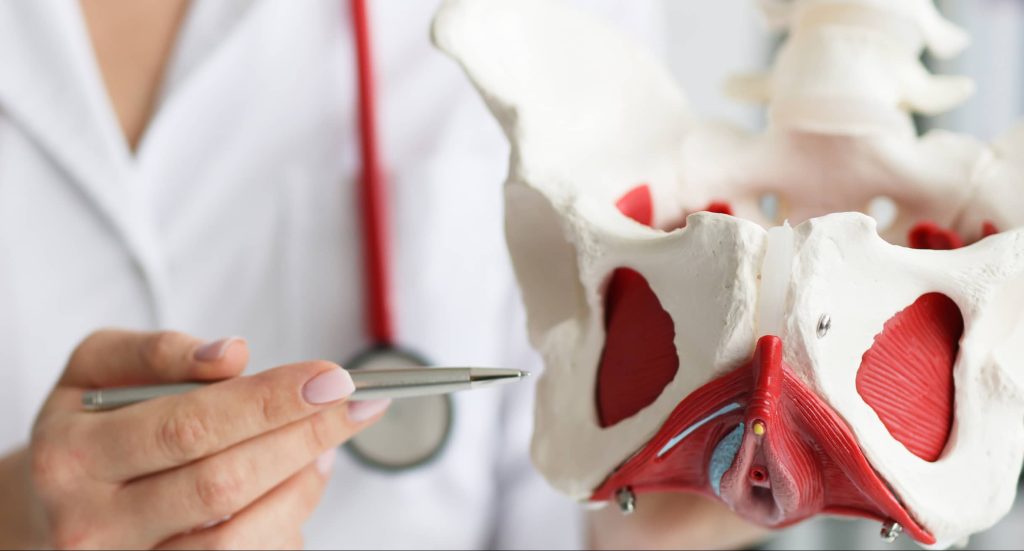
Is your life silently affected by tightness in the pelvic floor area? It’s crazy, but this condition often stays hidden without being recognized. Even though it’s shockingly common, affecting around 1 in every 10 people.
Today, we’re here to talk about the role of physiotherapy in managing pelvic floor hypertonia. It’s a game-changer that can be a huge difference without needing a bunch of muscle relaxants.
But before we dive in, let’s clarify what it actually is and what can cause this condition.
Understanding Pelvic Floor Hypertonia

Just like any other muscle in our body, the pelvic floor muscles can experience tension which can cause discomfort and various other symptoms. This state is known as the hypertonic pelvic floor.
It can cause problems like pelvic pain, trouble with peeing or pooping, and difficulties with sexual function. Everyone can experience tightness or tension in their pelvic floor muscles.
Therefore, seeking guidance from a specialized healthcare professional, like a pelvic health physiotherapist, can effectively address and manage this condition.
What Are The Symptoms And Causes of Hypertonic Pelvic Floor?

Pelvic floor hypertonicity can manifest as various symptoms, with pain being a common experience. This pain can be a general discomfort or pressure in the pelvic area, low back, or hips.
It may also be specific to certain locations, such as the bladder, or during activities like bowel movements or sexual intercourse. Following are some symptoms and causes.
Symptoms
- Pelvic pain or discomfort
- Urinary urgency or frequency
- Difficulty with urination or incomplete emptying of the bladder
- Bowel issues, like constipation or difficulty passing stools
- Painful sexual intercourse
- Musculoskeletal issues in the lower back, hips, or pelvic region
Causes
- Chronic stress and tension
- Poor posture and body mechanics
- Trauma or injury to the pelvic area
- Hormonal changes, such as during pregnancy or menopause
- Overactive or tight pelvic floor muscles
- Certain medical conditions or surgeries affecting the pelvic region
But sometimes, when we feel anxiety or stress or have undergone challenging experiences, it can also tense the pelvic floor muscles.
Since the symptoms can vary, it’s crucial to talk to a Pelvic PT. They can help determine if you are experiencing this condition and create a personalized treatment plan specifically for your case.
Diagnosis and Tests
Your healthcare provider will gather information and conduct various tests to diagnose a hypertonic pelvic floor. They will ask about your symptoms, medical history, and factors like bowel movements, urination, and sexual activity.
A thorough physical examination may be performed, which may include:
- A visual inspection of the pelvic area
- A digital rectal exam
- And a pelvic exam
Additional tests may be recommended, such as
- Anorectal manometry to measure muscle contractions
- Electromyography to assess muscle electrical signals
- Defecography to evaluate bowel movements,
- Urodynamic tests to assess bladder function.
The Role of Physiotherapy in Treatment

Physiotherapy plays a crucial role in effectively treating hypertonic pelvic floor conditions. Through specialized interventions and guidance, physiotherapy helps individuals regain control and find relief.
With their specialized knowledge in pelvic health, physiotherapists provide customized treatment plans that cater to each person’s unique needs. They provide education on the condition, its causes, and self-care strategies.
With a focus on relaxation, strengthening, and coordination exercises, physiotherapy helps individuals achieve optimal muscle function and reduce tension in the pelvic floor.
Physiotherapy empowers individuals to manage their hypertonic pelvic floor and enhance their overall well-being by:
- Promoting awareness
- Improving muscle control
- Addressing associated symptoms
Physiotherapy Techniques for Pelvic Floor Hypertonia
Physiotherapy offers effective techniques to address pelvic floor hypertonicity and promote muscle relaxation. One approach is pelvic floor muscle training, which includes hypertonic pelvic floor exercises like:
- Butterfly exercise: Sit on the floor, bring the soles of your feet together, and gently press your knees downward. This targets your adductor muscles, promoting relaxation and flexibility in the pelvic area.

- Squat exercise: With your feet comfortably apart, lower yourself into a squatting position by bending your knees and hips. And then slowly rise back up. This helps decrease tension in the pelvic floor muscles, allowing them to relax and restore their natural tone.

- Child’s Pose: Start by positioning yourself on all fours, then shift your weight back onto your heels while gently lowering your chest towards the floor. At the same time, extend your arms forward in front of you. This pose opens up the adductor and glute muscles, promoting relaxation and relieving tension in the pelvic area.

Remember to take your time with hypertonic pelvic floor exercises and breathe properly to allow the pelvic floor muscles to fully relax.
Physical therapists may utilize strategies such as biofeedback to teach proper muscle contraction and relaxation. They may also use techniques like massage, stretching, and joint movement.
Other Recommended Treatments
- Acupuncture
- Medications for symptom management
- Nerve stimulation for urinary or bowel incontinence
- Trigger point injections with corticosteroids or Botox for pain relief
- Breathing Techniques, i.e., Diaphragmatic breathing, 360° breathing, and alternate nostril breathing
Conclusion
So if you are looking for pelvic floor therapy in Tulsa, our dedicated team of physiotherapists is here to provide you with the best care and therapy to help you recover from hypertonic pelvic floor issues.
With our expertise in pelvic health and tailored treatment plans, we aim to support your journey toward a pain-free and active lifestyle. Contact us today to schedule your personalized pelvic floor therapy session and get back to doing what you love.
But if you’re not in Tulsa, you can simply search on Google for “PT near me” to find physiotherapy clinics in your local area.
FAQs
Why do I have a hypertonic pelvic floor?
It can vary from person to person. It can be triggered by factors such as chronic stress, poor posture, trauma or injury, hormonal changes, or naturally overactive or tight pelvic floor muscles.
What are hypertonic pelvic floor female symptoms?
Hypertonic pelvic floor female symptoms are incomplete emptying of the bowels, low back pain, painful sex, pelvic pain, hip pain, straining when emptying the bowels, and constipation.
